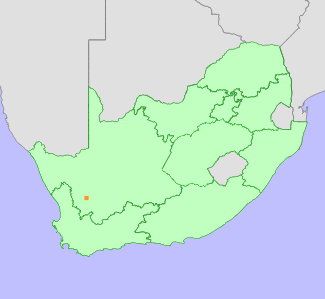|
Scientific Name | Hesperantha filiformis Goldblatt & J.C.Manning |
Higher Classification | Monocotyledons |
Family | IRIDACEAE |
National Status |
Status and Criteria | Critically Rare |
Assessment Date | 2021/05/28 |
Assessor(s) | T. Patel |
Justification | This species has an extent of occurrence (EOO) and area of occupancy (AOO) of 4 km². It is known from one site and has no known threats. It is therefore listed under the IUCN 3.1 Criteria, globally, as Least Concern but nationally as Critically Rare. |
Distribution |
Endemism | South African endemic |
Provincial distribution | Northern Cape |
Range | It is endemic to South Africa, and is known only from the Hantamsberg Plateau near Calvinia in Northern Cape. |
Habitat and Ecology |
Major system | Terrestrial |
Major habitats | Fynbos |
Description | It occurs in moist red clay among dolerite boulders. |
Threats |
| This species has no known threats. |
Population |
It is known from only one record in 2014, and it appears to be relatively common over a wide area (Goldblatt, et.al. 2015). Population trends are unknown.
|
Population trend | Unknown |
Bibliography |
Goldblatt, P. and Manning, J.C. 2020. Iridaceae of southern Africa. Strelitzia 42. South African National Biodiversity Institute, Pretoria.
Goldblatt, P., Manning, J.C. and Van Wyk, P.C.V. 2015. New species, combinations and range extensions in Hesperantha Ker Gawl. (Iridaceae: Crocoideae) from western South Africa. South African Journal of Botany 98:114-121.
|
Citation |
| Patel, T. 2021. Hesperantha filiformis Goldblatt & J.C.Manning. National Assessment: Red List of South African Plants version 2024.1. Accessed on 2025/12/13 |
 Comment on this assessment
Comment on this assessment

